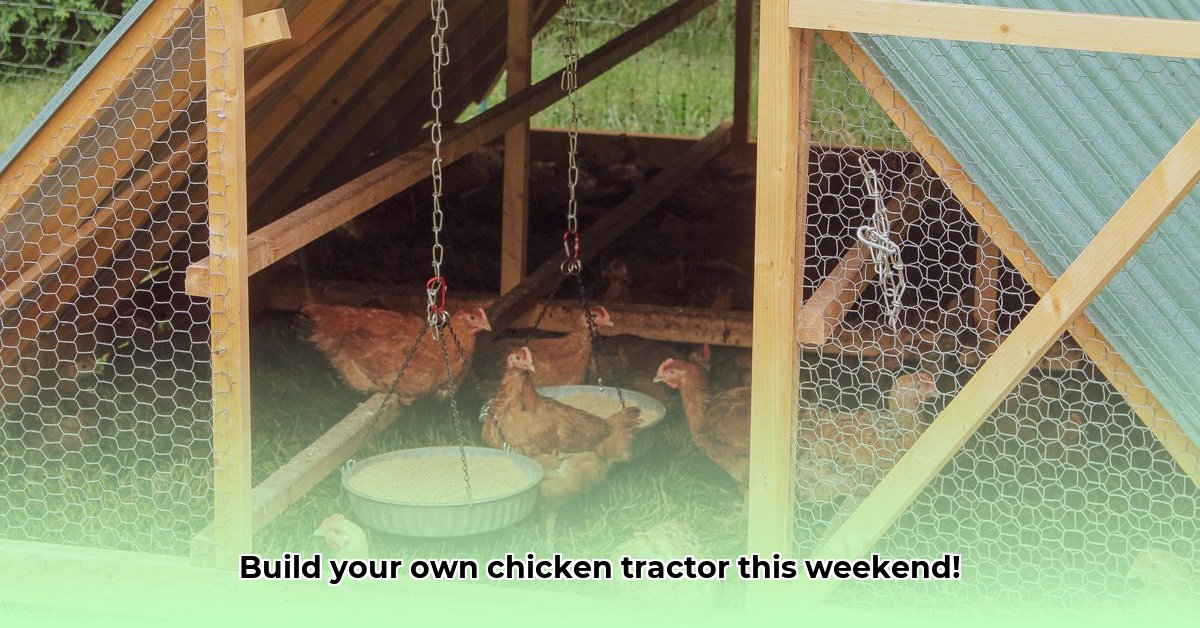
Ready to raise happy, healthy chickens and enjoy fresh eggs while embracing sustainable farming practices? Building your own chicken tractor is a rewarding weekend project that's easier than you think! This guide provides comprehensive, step-by-step instructions to build a mobile chicken coop that's both practical and eco-friendly, addressing various design considerations to help you choose the best approach for your specific needs and context. For even more detailed plans, check out this helpful guide.
Choosing Your Chicken Tractor Design: Tailoring Your Plan
Before you begin, let's determine the ideal chicken tractor design for your flock and property. Consider these key factors:
- Flock Size: How many hens will you house? A larger flock requires a more spacious coop.
- Terrain: Is your yard flat and even, or hilly and uneven? A lightweight design is suitable for flat ground, while a more robust design with sturdy wheels is better for uneven terrain.
- Predator Pressure: What are your local predator threats? Higher predator pressure necessitates a stronger, more secure design.
Here's a decision-making guide to help you choose:
| Number of Hens | Terrain | Predator Pressure | Recommended Design Features |
|---|---|---|---|
| 1-4 | Flat, level | Low | Lightweight, simple, easy to move |
| 5-8 | Relatively flat | Medium | Medium weight, sturdier build, more spacious |
| 9+ | Any terrain | High | Heavy-duty, secure construction, multiple sections (if needed) |
The Base Decision: Solid or Open Bottom?
A critical design choice is the base type: solid or open. Both have advantages and disadvantages:
- Solid Bottom: Offers superior protection from burrowing predators, easier cleaning, and better moisture control. However, it can be more challenging to clean thoroughly and may not be ideal in extremely wet climates.
- Open Bottom: Provides excellent ventilation, easier cleaning, and allows chicken droppings to fertilize the ground. However, it offers less protection from ground-dwelling predators.
The best choice depends on your specific priorities and local conditions. If predator pressure is high, a solid base is recommended. If easy cleaning and soil fertilization are paramount, an open bottom might be preferable. Remember, using robust hardware cloth significantly reduces predator access regardless of the base design.
Materials List: Sustainable & Durable Choices
This list provides a foundation. Tailor quantities to your chosen design and consider sustainable/recycled alternatives wherever possible.
- Lumber: Pressure-treated 2x4s or 2x6s (amount depends on coop size). Consider reclaimed or sustainably harvested wood.
- Hardware Cloth (1/2" mesh): Crucial for predator protection. Don't compromise on quality.
- Roofing Material: Durable, waterproof material like metal roofing sheets or corrugated plastic.
- Wheels: Heavy-duty wheels suitable for your terrain.
- Fasteners: Galvanized steel screws, hinges, and latches.
- Optional: Chicken wire for ventilation (especially with a solid base), exterior paint, perches, nesting boxes.
Step-by-Step Construction: Building Your Chicken Tractor
These instructions assume basic carpentry skills. If you're unsure, consult an experienced builder.
Step 1: Building the Frame: Construct the basic frame using your chosen lumber. Pre-drill holes before screwing pieces together to avoid splitting the wood. Ensure the frame is square and strong.
Step 2: Adding the Hardware Cloth: Securely attach the hardware cloth to the entire frame, ensuring no gaps. Use staples or screws for a tight fit. This is a critical step in predator protection.
Step 3: Constructing the Roof: Attach a durable and waterproof roof. Proper roofing ensures protection from the elements and adds structural integrity.
Step 4: Installing the Wheels: Securely attach heavy-duty wheels to the bottom of the frame for easy mobility.
Step 5: Adding the Finishing Touches: Install hinges, secure latches, and add internal features like perches and nesting boxes (optional). A final coat of weatherproof paint will enhance durability and aesthetics.
Predator Protection: Multiple Layers of Defense
Protecting your hens requires a multi-faceted approach:
- Solid Base (if chosen): A strong base is the first line of defense against burrowing predators.
- Secure Hardware Cloth Enclosure: A completely sealed enclosure made with high-quality hardware cloth prevents access for most predators.
- Secure Latches & Hinges: Strong, secure closures are crucial to preventing entry.
- Elevated Design (Optional): Raising the coop slightly off the ground can deter some predators.
- Supplementary Measures: Consider additional deterrents like noisemakers or visual deterrents depending on your local wildlife.
Maintenance and Cleaning: Keeping Your Coop Healthy
Regular cleaning is essential for your hens' health and the longevity of your chicken tractor. Remove droppings weekly, and conduct more thorough cleaning every few months. Regularly inspect for damage and repair promptly.
Conclusion: Enjoy Fresh Eggs & Sustainable Farming!
Building your own chicken tractor offers a rewarding experience, marrying practicality with sustainable agricultural practices. By following these plans and choosing the design that best suits your needs, you'll successfully provide a safe, mobile, and enriching environment for your flock. Remember to adapt and refine your design based on your experience and local conditions. Happy building!